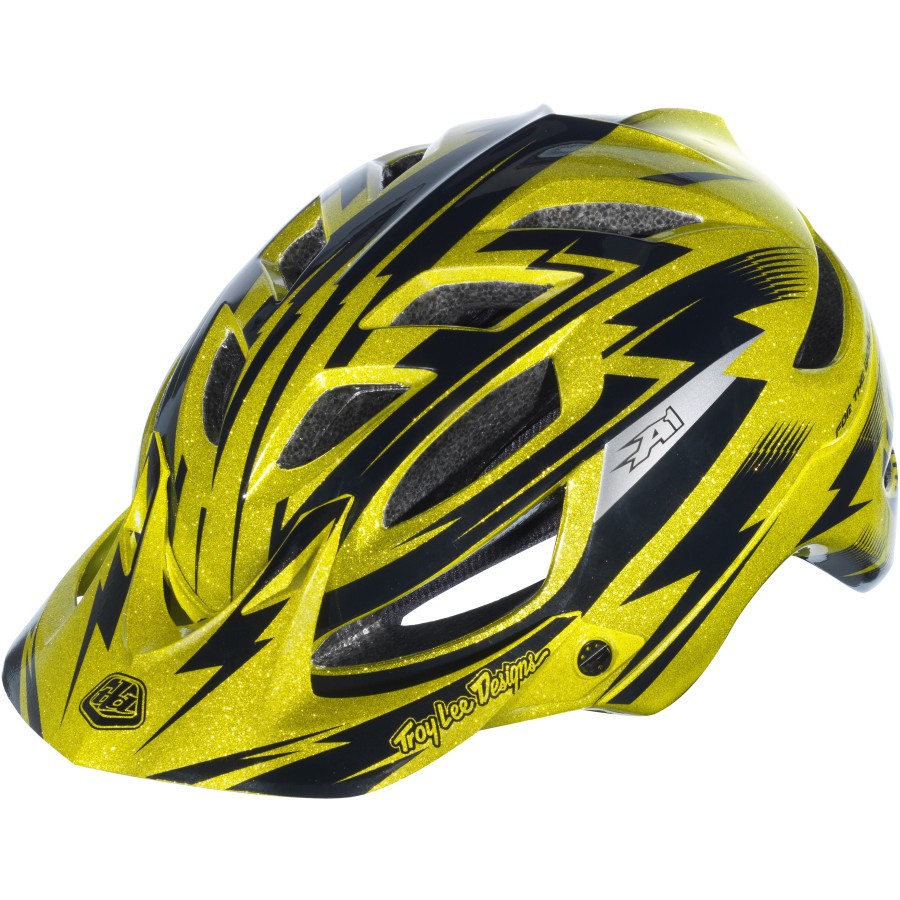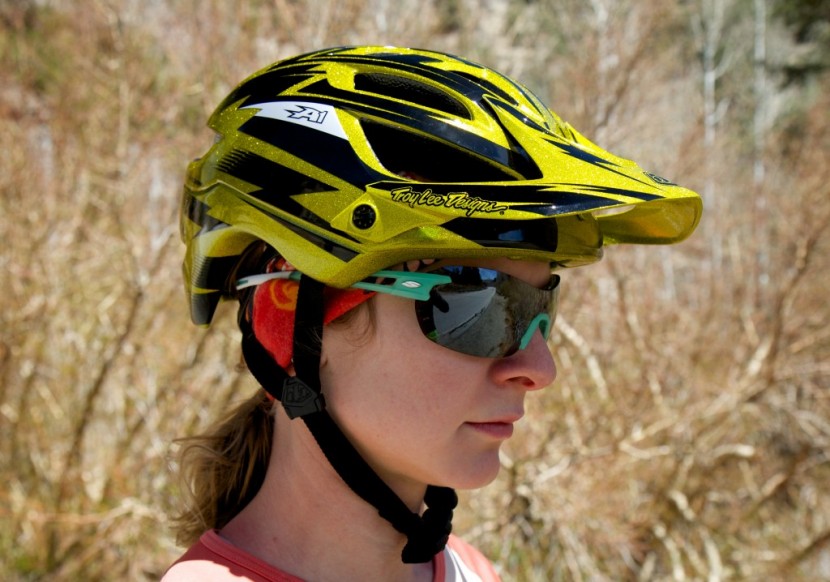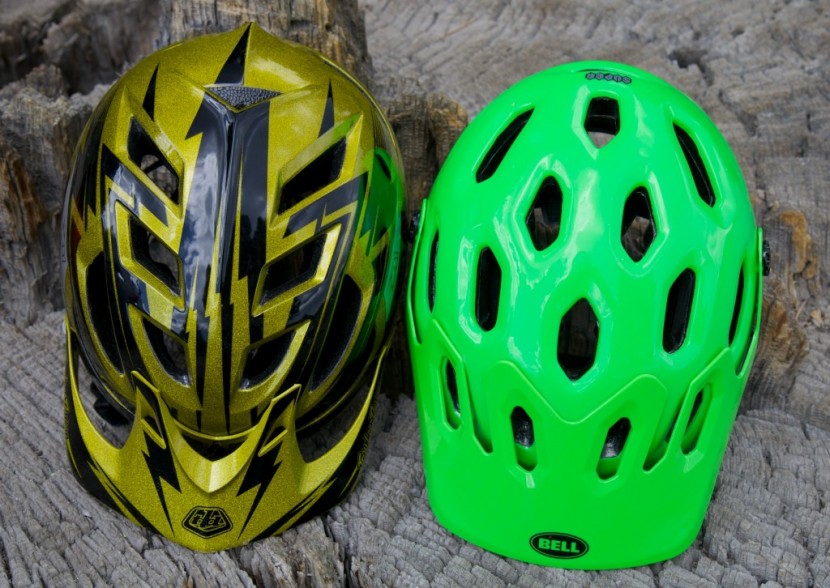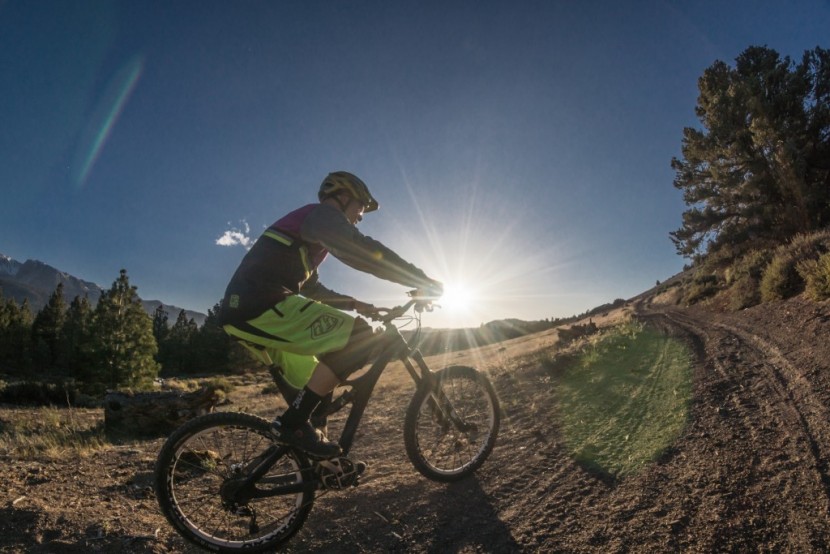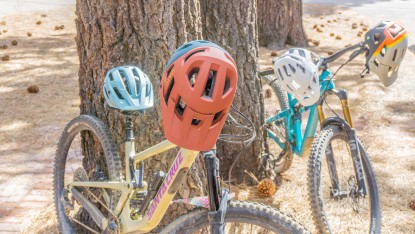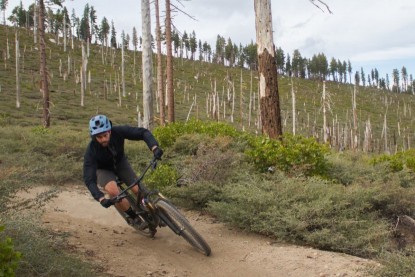The Troy Lee A1 took home the top prize for our mountain bike helmet review, making it the easy choice for our Editors' Choice Award. It beat out a competitive field of six other modern, extended coverage half-shell helmets, including the Bell Super, the A1's closest competitor.
We think that many riders reading this review will likely be trying to decide between the A1 and the Bell Super which earned our Top Pick Award. We think both helmets are great options, and we recommend you also read our full Bell Super review before you decide. In short, the A1 is lighter, better ventilated, has better day-to-day durability, and all of our testers found it to be way more comfortable than the Super. We also think the A1 is a better-looking helmet. The Super is less expensive and has better visor articulation, which is important if you want to wear goggles up on the front of the helmet while you climb. The Super also comes with a couple extras you may or may not need, like an integrated GoPro mount and guides so you can run goggles without a visor. The full face version of this helmet, the D3, won our Editors' Choice Award in the Best Downhill Helmet Review.Troy Lee A1 Review
Our Verdict
Our Analysis and Test Results
Hands-On Review of the A1 Helmet
The Troy Lee A1 is an injection molded polystyrene and polycarbonate mountain bike helmet and is our favorite helmet in the modern extended coverage helmet game.
Comfort
The unanimous opinion by every tester who wore this helmet is that this is the most comfortable mountain bike helmet they had ever worn. Period. The A1 has a feeling of cupping the entire head, as opposed to sitting on top like some old school designs. We'd say that its fit is glove-like, but it's actually better than that, we'd describe it a bit like a suction cup. Once you put it on, it requires almost no tightening of the rear retention band for a secure fit. We attribute the excellent fit to a combination of its deep profile and well-placed padding.
The A1 uses a single piece of moderately dense padding that covers pretty much all of the raised areas of foam on the inside of the helmet that would otherwise contact the head. Should you decided to remove and wash it, it's nice that the padding is linked into a single piece since it will be quicker and easier to reinstall and less likely to get lost.
The retention band is unpadded but is free from pressure points because of its excellent design.
The one reason that the A1 did not receive a perfect 10 comfort score had little to do with the helmet itself and more to do with sunglasses you are likely to wear with this helmet. A few of our testers found that the extended temporal area of the A1 pressed on the arms of wider than average sunglasses. The shape of the helmet requires that sunglass arms be worn inboard of the front yoke strap anchor point. We also found that very tall sunglasses will contact the front of the helmet when worn high on the bridge of the nose. For instance, our lead tester found that Smith Pivlock V2 sunglasses would contact the front of the helmet and press down on his nose uncomfortably, while the slightly shorter Smith V90 had no compatibility issues. There are a lot of variables here, but we think that if you are on the larger end of the size range you may need to pair this helmet with shorter or narrower sunglasses to prevent pressure points.
Adjustments
The rear retention band on the A1 is adjusted with an easy to find and use click wheel. The wheel is indexed, which means that it clicks loudly at each adjustment stop, similar to modern trigger or grip shifters. We really like this click wheel since it can be used either between the thumb and index finger or by the thumb alone. We found that when we wanted to make a quick adjustment when hammering in the saddle, it was easiest to palm the back of the helmet and quickly spin the wheel with a thumb.
The A1's entire harness consists of a single piece of flat webbing which sits flat agains the face and is quickly forgotten about. To accommodate for different head sizes, the webbing can be shifted from one side of the harness to the other by tugging it through the rear anchor point. We found that the rear anchor point had just enough friction on the webbing to keep it from randomly moving and requiring repositioning between or during rides.
Troy Lee left no detail out, using locking plastic yoke hardware which bears a TLD logo and allows the harness yoke to be adjusted fore and aft to provide for a secure fit without a choking feeling.
Weight
Our Medium/Large A1 helmet tipped our scale at 12.9 ounces, which put it just 0.2 ounces heavier than the average of the seven helmets we tested, the average being 12.7 ounces. While the scale doesn't lie, we found that the perceived weight of a helmet on the head has as much to do with how well a helmet fits as it does with the numbers on the scale. As we mentioned in the comfort category, the A1 has a glove-like fit, which makes it feel much lighter than it actually is.
If counting grams is intrinsic to your favorite hobby, then you will want to take a look at the Giro Xar which is the lightest lid in our test at 11.3 ounces. Also check out the Giro Feature and Bell Stoker, which only weigh around a half ounce more than the Xar, but cost considerably less.
The helmet many riders will be comparing the A1 to is the Bell Super, which was the heaviest helmet in our test. The size medium Super we tested weighed in 1.7 ounces heavier than the A1 at 14.6 ounces. Worn one after the other, the Super always felt slightly heavier than the A1, partially due to the added weight but also due to the superior fit of the A1, which makes it feel lighter than it is.
Ventilation
The A1 has 16 medium and small vents through its shell, which keep the air flowing through the helmet. The vents on the front, top, and side are connected with large air channels that help take in cool air and force hot air out, provided you are moving at a decent pace. We found that the A1 required more air flow to keep it cool than other helmets, likely because it covers more of the head than other designs.
The A1 tied the POC Trabec, Giro Feature, and Bell Stoker with an above average rating in our ventilation test. The only helmet to outscore these helmets in our test was the Giro Xar, which has arguably less coverage than the A1 but does have better airflow. The A1 was noticeably cooler while cranking than the Bell Super, which has 25 small vents and was the hottest helmet we tested.
Features
The A1 has the second best visor of the helmets in our test. Our absolute favorite visor was found on the Bell Super, which took a perfect score in the features test. The A1's visor adjusts with a thumb screw, similar to the Super's visor and the visor on the Giro Feature. This is the most effective method for visor adjustment that we have experience with.
The A1's visor is very close in size to that of the Super. The Super's visor is squarer at the edges than the A1's, which gives the Super's visor slightly more coverage at the corners. The biggest difference is that the Super's visor articulates much more than the visor on the A1. This allows goggles to be worn on the front of the helmet beneath the visor for climbing or whenever you don't want them on your face. The A1's visor will not move up far enough for goggles to be worn on the front of the helmet beneath the visor. If you are dead set on doing this, one option with the A1 would be to flip the goggles around backwards and run the strap beneath the visor with the lenses on the back of the helmet. Otherwise, you can wear them around your neck or arm like pro riders in the hot seat.
The tops score in the features test went to the Super because of the visor as well as the included GoPro mount and removable goggle guides that allow for goggles to be worn without the visor.
Durability
The A1 took the top score in our durability test largely due to its full-wrap polycarbonate shell, which completely covers the lower edge of the polystyrene foam, protecting it from dents and dings. Though it adds a tiny bit of weight, we greatly prefer helmets with full-edge shell coverage and feel that it is one of the marks of a quality product.
The three screws which attach the visor to the helmet as well as the inserts they screw into are all aluminum, making them less likely to fail than plastic screws and inserts. If you happen to loose one of these screws, they are available on the Troy Lee website for $3 each. Pricey, but nice to know you can get a matching replacement if you want one.
The A1 meets the CE EN 1078 and CPSC standards for bicycle helmets.
Best Application
The extended coverage A1 is best suited to general mountain biking and enduro racing.
Value
We think the A1 is the best half-shell mountain bike helmet we have ever worn, but there are better values on the market. The Bell Stoker and our Best Buy Award winner, the Giro Feature, retail for around half the price of the A1 and both weigh less. Remember that all bicycle helmets should be replaced after a significant crash, which is a valid reason to spend less on a somewhat disposable item.
Conclusion
This is the best extended coverage mountain bike helmet that we have tried. The A1 is the most comfortable helmet we've ever worn and is the helmet we want to be wearing for anything from cross-country to enduro racing. It is very durable, has excellent coverage, and has one of the best visors available. The only negatives we've found with it is that it's slightly heavy and is incompatible with some head/face eyewear combinations. We think you should buy the A1 if you want the best of the best regardless of cost.


